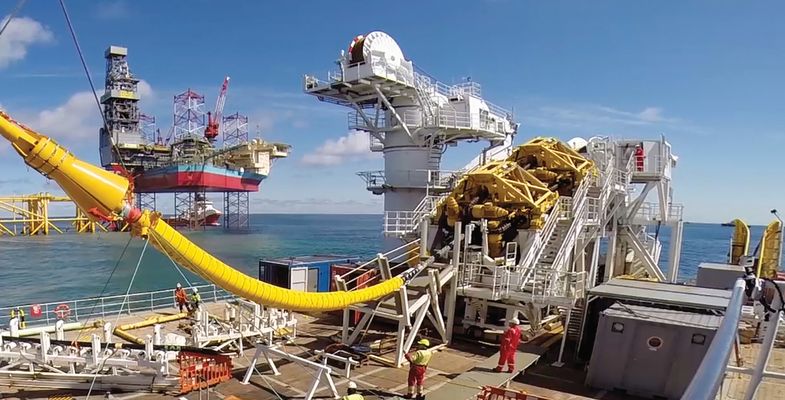ISO 13628-6 Subsea Production Control System Testing
The ISO 13628-6 standard is pivotal in ensuring the reliability and safety of subsea production control systems (SPCS) used in offshore oil and gas operations. These systems are critical for managing the flow of hydrocarbons from subsea reservoirs to processing facilities onshore or at sea. This service ensures that SPCS meet stringent performance, environmental, and operational requirements set forth by international standards.
The primary focus of this testing is to assess the robustness and functionality of SPCS under simulated real-world conditions. The test parameters include pressure cycling, temperature cycling, vibration, and immersion in corrosive environments such as seawater. These tests are designed to replicate the harsh marine environment where these systems operate, ensuring they can withstand extreme conditions without failure.
For quality managers and compliance officers, this service provides assurance that equipment meets regulatory requirements and industry best practices. R&D engineers benefit from detailed insights into potential weaknesses in design or manufacturing processes. Procurement teams gain confidence knowing that the SPCS they purchase will perform reliably under harsh marine conditions.
The testing process involves several key steps: initial setup of the system, application of test parameters, monitoring performance metrics, and final analysis to determine compliance with ISO 13628-6 standards. Specimen preparation is crucial; this includes ensuring that all components are representative of those found in actual installations.
Instrumentation plays a critical role in collecting data during tests. Sensors measure variables like pressure, temperature, and fluid flow rates. Data logging systems ensure accurate recording throughout the testing period. Reporting involves generating comprehensive test reports detailing performance metrics against specified acceptance criteria.
| Parameter | Description | Acceptance Criteria |
|---|---|---|
| Pressure Cycling | Simulates the effects of pressure variations on system components. | All components must withstand specified pressure changes without failure. |
| Temperature Cycling | Evaluates thermal stress on materials and assemblies over a range of temperatures. | Materials should maintain integrity throughout all temperature cycles. |
| Vibration | Replicates operational vibration experienced in marine environments. | Components must retain functionality after specified levels of vibration exposure. |
| Corrosion Resistance | Determines resistance to seawater corrosion for submerged components. | Corrosion rates should be below specified thresholds. |
The testing process is both rigorous and comprehensive, ensuring that SPCS are reliable, safe, and capable of operating optimally under the most challenging conditions. This service not only meets but exceeds industry expectations for subsea production control systems.
For organizations involved in offshore energy projects, this testing can significantly reduce risks associated with equipment failure, enhance operational efficiency, and contribute to overall safety standards in marine operations.
Scope and Methodology
The scope of ISO 13628-6 subsea production control system testing encompasses a series of defined procedures aimed at assessing the performance and integrity of SPCS. The methodology is designed to simulate real-world operational conditions, ensuring that tested systems can withstand environmental stresses without degradation or failure.
Initial Setup: Each test begins with careful setup of the subsea production control system within a controlled environment replicating marine conditions as closely as possible.
Application of Test Parameters: Specific parameters such as pressure, temperature, vibration, and immersion in corrosive environments are applied systematically to evaluate system performance under these conditions.
Monitoring Performance Metrics: Throughout the testing period, critical performance metrics are continuously monitored using advanced instrumentation. Key data points include fluid flow rates, pressure changes, and component stability.
Final Analysis: Upon completion of all test cycles, a thorough analysis is conducted to evaluate compliance with ISO 13628-6 standards. Any deviations from acceptable criteria are documented for further investigation or corrective action.
The methodology ensures that every aspect of the subsea production control system undergoes rigorous evaluation, providing stakeholders with confidence in its reliability and safety.
Why Choose This Test
Selecting ISO 13628-6 subsea production control system testing is essential for ensuring the highest standards of quality and reliability. Here are several reasons why this test should be your priority:
Compliance with International Standards: This service adheres strictly to international standards, ensuring that tested systems meet global regulatory requirements.
Rigorous Testing Protocols: The testing process is designed to replicate the harshest operational conditions, providing robust assurance of system performance.
Expertise and Experience: Our team comprises experts with extensive experience in subsea equipment testing, offering unparalleled expertise and precision.
Comprehensive Reporting: Detailed reports provide comprehensive insights into test outcomes, facilitating informed decision-making.
Reduced Operational Risks: By identifying potential issues early on through thorough testing, this service helps minimize risks associated with equipment failure in marine operations.
Enhanced Safety Standards: Ensuring that subsea production control systems meet the highest safety standards contributes significantly to overall operational safety.
In choosing this test, organizations can rest assured of their commitment to quality and reliability, thereby enhancing their reputation in the industry and ensuring long-term success.
Quality and Reliability Assurance
Ensuring that subsea production control systems meet stringent performance criteria is crucial for maintaining operational efficiency and safety. Here are some key measures we employ to guarantee the quality and reliability of our testing:
Advanced Instrumentation: Utilizing state-of-the-art sensors and data logging systems, we accurately measure critical parameters throughout the testing process.
Controlled Environmental Conditions: Testing takes place in a controlled environment that closely replicates real-world marine conditions, ensuring accurate performance evaluation.
Comprehensive Data Analysis: Detailed analysis of collected data provides insights into system behavior under various stressors.
Expert Review Panels: Our team of industry experts reviews all test results to ensure compliance with ISO 13628-6 standards and identifies any areas requiring improvement or modification.
These measures are integral to our commitment to delivering reliable, high-quality testing services that meet the highest international standards.





